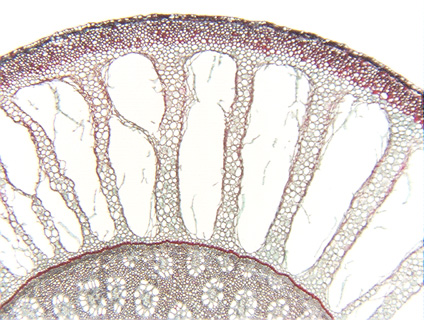 Fig.
3.3-4. Transverse section of rush (Juncus). Like the stems of Scirpus
(Fig. 3.3-3) this one of Juncus is light-weight due to having intercellular
air spaces, but in Juncus they are very large spaces, and in
fact as much as half the volume of the stem is just air space, not cellular
material. Notice all the debris in the intercellular spaces – those are
remnants of cells destroyed as neighboring cells were pulled apart. The top of
the micrograph shows vascular tissues, and the white spaces arranged in circles
are xylem vessels. The red band between the outer aerenchymatous cortex and the
vascular tissues is the endodermis (pages 151-152 and 275-278 in Plant
Anatomy (Mauseth)).
Fig.
3.3-4. Transverse section of rush (Juncus). Like the stems of Scirpus
(Fig. 3.3-3) this one of Juncus is light-weight due to having intercellular
air spaces, but in Juncus they are very large spaces, and in
fact as much as half the volume of the stem is just air space, not cellular
material. Notice all the debris in the intercellular spaces – those are
remnants of cells destroyed as neighboring cells were pulled apart. The top of
the micrograph shows vascular tissues, and the white spaces arranged in circles
are xylem vessels. The red band between the outer aerenchymatous cortex and the
vascular tissues is the endodermis (pages 151-152 and 275-278 in Plant
Anatomy (Mauseth)).